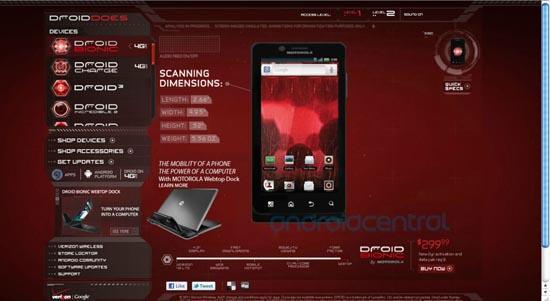
Remember that trend talk we had a little while ago? It seems that another trend is starting to creep its way into the mainstream, and unfortunately it doesn’t look like it’s going to be the best one out there. This particular trend doesn’t seem to be hitting all of the major wireless carriers (yet), but it is being started by one of the biggest ones, which doesn’t necessarily bode well for the rest. I’m talking about Verizon’s apparent standard for 4G-enabled high-end Android-powered smartphones.
There were some who thought that the Samsung DROID Charge’s pricing was due to its 4.3-inch Super AMOLED Plus display, along with all of the other features it has tucked away inside its slender frame. The fact that there is 4G-connectivity didn’t seem like it would be the out-right cause of a $100 price increase versus the standard smartphone pricing available for Big Red’s network. Unfortunately, that trend word is starting to take shape with a recent leak of the Motorola DROID Bionic’s specifications page.
We’ve actually asked twice here if the Motorola DROID Bionic will be worth the wait when it launches (hopefully in August), and so far the reaction seems to be the same: if it gets out before the release of some other major phones, like the iPhone 5, then it has a chance at drawing in some new customers. Basically, the rumors suggest that August 4th is the launch date, and it looks like if Motorola and Verizon miss that date, then they’ve really got no reason to launch the device.
However, that was before the leaked specs page theoretically revealed the upcoming price of the device. Even if Motorola and Verizon do manage to make the rumored and expected release date for the device, that price may be enough to push people away, rather than draw them in. More to the point, the $299.99 price tag may just be too much for the high-end 4G-enabled devices that Verizon is launching. And to me, that means that the HTC ThunderBolt, which was Verizon’s first 4G-enabled device to hit store shelves, wasn’t actually considered a high-end device from Verizon since it didn’t come with the $299.99 price tag.
But the device sold well enough, and I imagine that the price tag had something to do with it. If this is a trend that Verizon is going to keep around, I’m not sure Verizon’s expanding 4G network is going to see a lot of adoption all that quickly. Don’t get me wrong, there’s going to be plenty of people out there who buy the Motorola DROID Bionic and any other DROID 4G-enabled device that launches, but I think there may be the majority of those who wait for non-DROID 4G devices so they don’t have to pay the extra cash. And, let’s ask the simple question here: are we paying the extra money for the DROID name? Are we really paying more for a brand? Let’s hope it’s really about the technology and not the brand, shall we?
With the holiday season right around the corner, and obviously there being other devices from Samsung, HTC, Apple, and maybe even Motorola, I’m wondering how well the DROID Bionic will sell in August for $299.99. And then I wonder how long it will take before Verizon cuts the price. But what do you think about this new trend of pricing for DROID-branded 4G-enabled devices from Verizon? Do you think it fits? Or should Verizon take another look at the pricing sheet, and start moving some numbers around (to be less)? Let me know in the comments what you think.